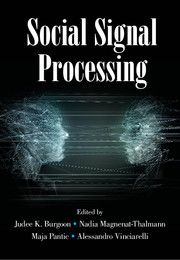Book contents
- Frontmatter
- Contents
- Contributors
- 1 Introduction: Social Signal Processing
- Part I Conceptual Models of Social Signals
- 2 Biological and Social Signaling Systems
- 3 Universal Dimensions of Social Signals: Warmth and Competence
- 4 The Vertical Dimension of Social Signaling
- 5 Measuring Responses to Nonverbal Social Signals: Research on Affect Receiving Ability
- 6 Computational Analysis of Vocal Expression of Affect: Trends and Challenges
- 7 Self-presentation: Signaling Personal and Social Characteristics
- 8 Interaction Coordination and Adaptation
- 9 Social Signals and Persuasion
- 10 Social Presence in CMC and VR
- Part II Machine Analysis of Social Signals
- Part III Machine Synthesis of Social Signals
- Part IV Applications of Social Signal Processing
- References
8 - Interaction Coordination and Adaptation
from Part I - Conceptual Models of Social Signals
Published online by Cambridge University Press: 13 July 2017
- Frontmatter
- Contents
- Contributors
- 1 Introduction: Social Signal Processing
- Part I Conceptual Models of Social Signals
- 2 Biological and Social Signaling Systems
- 3 Universal Dimensions of Social Signals: Warmth and Competence
- 4 The Vertical Dimension of Social Signaling
- 5 Measuring Responses to Nonverbal Social Signals: Research on Affect Receiving Ability
- 6 Computational Analysis of Vocal Expression of Affect: Trends and Challenges
- 7 Self-presentation: Signaling Personal and Social Characteristics
- 8 Interaction Coordination and Adaptation
- 9 Social Signals and Persuasion
- 10 Social Presence in CMC and VR
- Part II Machine Analysis of Social Signals
- Part III Machine Synthesis of Social Signals
- Part IV Applications of Social Signal Processing
- References
Summary
A Biological and Social Imperative
Adaptation is a biological and social imperative – biologically, for the survival of a species; socially, for the survival of a society. Vertebrates and invertebrates alike come equipped with reflexes that produce involuntary survival-related forms of adaptation in the form of fight or flight responses. In the face of a threat, a frightened organism may sound an alarm call, emit an odor, or display a visual signal that is recognized by species mates as fear. The fear triggers behavioral mimicry that leads the entire flock, herd, swarm, or school to take flight en masse. Or, rage by a single individual may fuel a contagion of aggression that turns into mob violence. These reciprocal actions may not be easily suppressed or controlled.
Other forms of adaptation are volitional, intentional, and socially oriented. Humans may copy the speech patterns of their social “superiors” in hopes of being viewed as belonging to the same ingroup. Or one person's antagonistic demeanor toward a target may elicit a docile, calming response by the victim.
Both forms of adaptation – involuntary and voluntary – undergird social organization. As Martin Luther King Jr. observed in his Letter from a Birmingham Jail (1963), “we are caught in an inescapable network of mutuality.” By means of verbal and nonverbal communication, civilized societies negotiate access to scarce resources, work out their interpersonal relationships, and create their social organizations. Thus, communication is fundamentally an adaptive enterprise that reflects and channels these biological and social imperatives. How, when, and why such adaptation takes place is the topic of this chapter.
Forms of Coordination and Adaptation
It is perhaps unsurprising that given its fundamental role in social interaction, terms describing various forms of adaptation have proliferated, leading to conceptual and operational disarray. The same terms have been applied to different phenomena and different terms have been applied to the same phenomenon. Here we introduce the most common usage from scholars of communication, psychology and linguistics who over the course of forty years have largely converged on these definitions. These conceptual and operational definitions are summarized in Table 8.1.
- Type
- Chapter
- Information
- Social Signal Processing , pp. 78 - 96Publisher: Cambridge University PressPrint publication year: 2017
References
- 14
- Cited by



